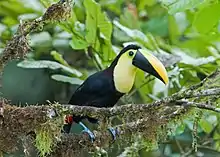Choco toucan
The Choco toucan (Ramphastos brevis) is a near-passerine bird in the family Ramphastidae found in humid lowland and foothill forests on the Pacific slope of Colombia and Ecuador. Within its range, extensive habitat destruction is taking place, but it remains fairly common locally.
| Choco toucan | |
|---|---|
 | |
| Scientific classification | |
| Kingdom: | Animalia |
| Phylum: | Chordata |
| Class: | Aves |
| Order: | Piciformes |
| Family: | Ramphastidae |
| Genus: | Ramphastos |
| Species: | R. brevis |
| Binomial name | |
| Ramphastos brevis Meyer de Schauensee, 1945 | |
 | |
| Estimated Choco toucan range in blue | |
| Synonyms | |
| |
Taxonomy and systematics
The Choco toucan was originally considered as a subspecies of the yellow-throated toucan.
Description

The Choco toucan is a large (although among the smallest Ramphastos toucans), predominantly black bird with a striking yellow and black beak, a yellow bib, white uppertail coverts, red undertail coverts and green ocular skin. It is very similar to the larger chestnut-mandibled toucan, but lacks brown on the beak. In the wild, the two are generally best separated by their voice; croaking in the Choco, yelping in the chestnut-mandibled.
Distribution
As suggested by its common name, the Choco toucan is restricted to the humid Chocó forests in western Ecuador and western Colombia. Its estimated global range is over 110,000 km².
Reproduction
Choco toucans lay 3-4 pure white eggs that are incubated for 16 days. The young fledge in about 45–50 days.
In captivity
In aviculture, their requirements of spacious cages and a high-fruit diet, and their sensitivity to hemochromatosis (iron-storage disease), make them difficult to maintain for novice keepers. The Choco toucan is very rare in captivity in the United States.
References
- BirdLife International (2012). "Ramphastos brevis". IUCN Red List of Threatened Species. 2012. Retrieved 26 November 2013.CS1 maint: ref=harv (link)
External links
| Wikimedia Commons has media related to Ramphastos brevis. |
- Photos of the Choco toucan on Mangoverde.
- Videos of the Choco toucan on the Internet Bird Collection
- Choco toucan photo gallery VIREO Photo-High Res-(Close-up)
